Was the Dunblane Inquiry Misled?
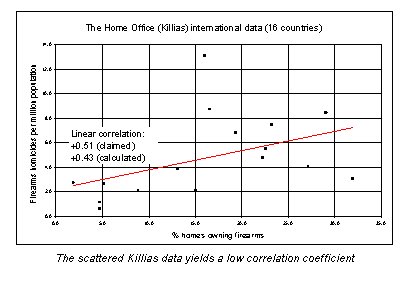 The justification for the handgun
ban proposals of the government and opposition parties was a
claimed link between the general level of firearms ownership and
firearms violence. The key international evidence of this link was
submitted by the Home Office to the Dunblane
inquiry. Whilst Lord Cullen acknowledged that the quality of
this evidence was open to severe criticism, he allowed that it
"shows that there is a relationship… when considered
overall" (Cullen, 9.21).
The justification for the handgun
ban proposals of the government and opposition parties was a
claimed link between the general level of firearms ownership and
firearms violence. The key international evidence of this link was
submitted by the Home Office to the Dunblane
inquiry. Whilst Lord Cullen acknowledged that the quality of
this evidence was open to severe criticism, he allowed that it
"shows that there is a relationship… when considered
overall" (Cullen, 9.21).
It was only after the closure of the evidence to the Dunblane
inquiry that Lord Cullen received James Hawkins's reductio ad
absurdum demonstration of the statistical weakness of this
notional "relationship": over the same set of countries,
firearms homicide correlates closer with car
ownership than it does with firearms ownership.
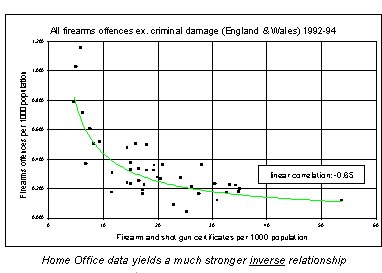 The Home Office,
however, had further evidence of the relationship between firearms
violence and firearms ownership levels in the UK itself, which it
did not submit to Lord Cullen. The Home and Scottish
Office's own figures on armed crime and firearms ownership by
constabulary area show a negative correlation. In Britain,
in areas where legal firearms ownership is higher, armed crime is
lower: and this is the case both for total offences and for every
individual category of armed crime. Moreover, factoring out the
differences between urban and rural areas yields the same result:
it is not just the total, but the proportion of crimes
committed with firearms that is lower where licensed firearms
ownership is higher.
The Home Office,
however, had further evidence of the relationship between firearms
violence and firearms ownership levels in the UK itself, which it
did not submit to Lord Cullen. The Home and Scottish
Office's own figures on armed crime and firearms ownership by
constabulary area show a negative correlation. In Britain,
in areas where legal firearms ownership is higher, armed crime is
lower: and this is the case both for total offences and for every
individual category of armed crime. Moreover, factoring out the
differences between urban and rural areas yields the same result:
it is not just the total, but the proportion of crimes
committed with firearms that is lower where licensed firearms
ownership is higher.
It is regrettable that the Home Office should have presented
Lord Cullen with a study which (setting aside its specific flaws
and weaknesses) suffered from the inherent fragility of any
international statistical comparison, whilst failing to present him
with the United Kingdom's own data which pointed to diametrically
opposite conclusions. The failure to present this evidence to Lord
Cullen has fundamentally undermined the firearms aspect of his
report, and the validity of the political decisions associated
therewith.
P H Jackson, J A G Hawkins, Prof. A R
Horrocks, R A I Munday; 9 November 1996
Notes:
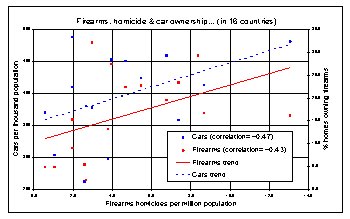 The Home Office submitted the
Killias research in support of the claim that firearms homicide
rates are related to firearms ownership levels in the countries
surveyed. As can be seen from the scatter plot of the data
(overleaf, top), the quality of fit of the data was not good, and
this is reflected in the trivial correlation coefficient. To
indicate how trivial this correlation is, the firearms ownership
data is replotted (right), together with car ownership data from
the same sixteen countries. Car ownership yields a greater
correlation with firearms homicide than does firearms
ownership.
The Home Office submitted the
Killias research in support of the claim that firearms homicide
rates are related to firearms ownership levels in the countries
surveyed. As can be seen from the scatter plot of the data
(overleaf, top), the quality of fit of the data was not good, and
this is reflected in the trivial correlation coefficient. To
indicate how trivial this correlation is, the firearms ownership
data is replotted (right), together with car ownership data from
the same sixteen countries. Car ownership yields a greater
correlation with firearms homicide than does firearms
ownership.
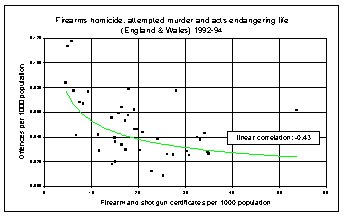 Domestic data
(right): firearms homicide and attempted murder and other acts
endangering life per thousand population plotted against numbers of
firearms licences per thousand population, for each police force in
England & Wales, for the period 1992-94. Unlike the Killias
data, this data set is complete, contains no estimates and uses
statistics recorded in a consistent manner. It also gives a quite
different result. Within the United Kingdom, areas of high
legal firearms ownership have a low incidence of firearms homicide
and attempted murder.
Domestic data
(right): firearms homicide and attempted murder and other acts
endangering life per thousand population plotted against numbers of
firearms licences per thousand population, for each police force in
England & Wales, for the period 1992-94. Unlike the Killias
data, this data set is complete, contains no estimates and uses
statistics recorded in a consistent manner. It also gives a quite
different result. Within the United Kingdom, areas of high
legal firearms ownership have a low incidence of firearms homicide
and attempted murder.
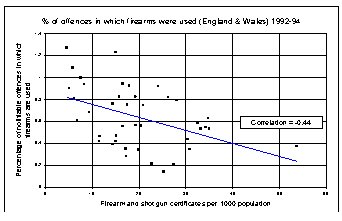 The graph plots all
firearms offences excluding criminal damage (mostly airgun
offences) for the same period, and shows a similar inverse
correlation. With the much larger number of incidents in this
category, it is clear that the relationship is stronger than
linear, as indicated by the inverse-square curves shown. These are
Home Office figures, and are directly relevant to Britain.
The graph plots all
firearms offences excluding criminal damage (mostly airgun
offences) for the same period, and shows a similar inverse
correlation. With the much larger number of incidents in this
category, it is clear that the relationship is stronger than
linear, as indicated by the inverse-square curves shown. These are
Home Office figures, and are directly relevant to Britain.
The Home Office also claimed, on the basis of the Clarke &
Mayhew studies, that in countries with high firearms ownership, a
higher proportion of homicides were committed using firearms. If we
plot England & Wales data on the same basis, we see that the
rate of use of firearms in all categories of crime is lower in
areas of high legal firearms ownership.
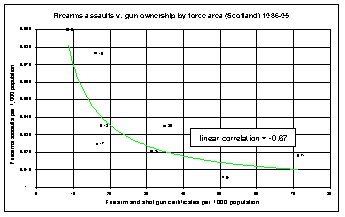 Scotland: recognising that crime categories and
recording policies vary between jurisdictions, we have analysed
Scottish Office data separately. The Scottish analysis yields very
similar results to those for England & Wales.
Scotland: recognising that crime categories and
recording policies vary between jurisdictions, we have analysed
Scottish Office data separately. The Scottish analysis yields very
similar results to those for England & Wales.
The authors invite critical review. The full set of data and
calculations summarised in this paper is available as crimstat.zip in the form of Excel
spreadsheet files bundled into a Zipfile.
P.H. Jackson +44 (1644) 470223
J.A.G. Hawkins +44 (1767) 631736
Prof. A.R. Horrocks +44 (1204) 528851
R.A.I. Munday +44 (1279) 842154
- Send mail to Peter at:
- Peter H Jackson <pjackson@forge.demon.co.uk>
Posted: Dec 1996
 The justification for the handgun
ban proposals of the government and opposition parties was a
claimed link between the general level of firearms ownership and
firearms violence. The key international evidence of this link was
submitted by the Home Office to the Dunblane
inquiry. Whilst Lord Cullen acknowledged that the quality of
this evidence was open to severe criticism, he allowed that it
"shows that there is a relationship… when considered
overall" (Cullen, 9.21).
The justification for the handgun
ban proposals of the government and opposition parties was a
claimed link between the general level of firearms ownership and
firearms violence. The key international evidence of this link was
submitted by the Home Office to the Dunblane
inquiry. Whilst Lord Cullen acknowledged that the quality of
this evidence was open to severe criticism, he allowed that it
"shows that there is a relationship… when considered
overall" (Cullen, 9.21). The Home Office,
however, had further evidence of the relationship between firearms
violence and firearms ownership levels in the UK itself, which it
did not submit to Lord Cullen. The Home and Scottish
Office's own figures on armed crime and firearms ownership by
constabulary area show a negative correlation. In Britain,
in areas where legal firearms ownership is higher, armed crime is
lower: and this is the case both for total offences and for every
individual category of armed crime. Moreover, factoring out the
differences between urban and rural areas yields the same result:
it is not just the total, but the proportion of crimes
committed with firearms that is lower where licensed firearms
ownership is higher.
The Home Office,
however, had further evidence of the relationship between firearms
violence and firearms ownership levels in the UK itself, which it
did not submit to Lord Cullen. The Home and Scottish
Office's own figures on armed crime and firearms ownership by
constabulary area show a negative correlation. In Britain,
in areas where legal firearms ownership is higher, armed crime is
lower: and this is the case both for total offences and for every
individual category of armed crime. Moreover, factoring out the
differences between urban and rural areas yields the same result:
it is not just the total, but the proportion of crimes
committed with firearms that is lower where licensed firearms
ownership is higher. The Home Office submitted the
Killias research in support of the claim that firearms homicide
rates are related to firearms ownership levels in the countries
surveyed. As can be seen from the scatter plot of the data
(overleaf, top), the quality of fit of the data was not good, and
this is reflected in the trivial correlation coefficient. To
indicate how trivial this correlation is, the firearms ownership
data is replotted (right), together with car ownership data from
the same sixteen countries. Car ownership yields a greater
correlation with firearms homicide than does firearms
ownership.
The Home Office submitted the
Killias research in support of the claim that firearms homicide
rates are related to firearms ownership levels in the countries
surveyed. As can be seen from the scatter plot of the data
(overleaf, top), the quality of fit of the data was not good, and
this is reflected in the trivial correlation coefficient. To
indicate how trivial this correlation is, the firearms ownership
data is replotted (right), together with car ownership data from
the same sixteen countries. Car ownership yields a greater
correlation with firearms homicide than does firearms
ownership. Domestic data
(right): firearms homicide and attempted murder and other acts
endangering life per thousand population plotted against numbers of
firearms licences per thousand population, for each police force in
England & Wales, for the period 1992-94. Unlike the Killias
data, this data set is complete, contains no estimates and uses
statistics recorded in a consistent manner. It also gives a quite
different result. Within the United Kingdom, areas of high
legal firearms ownership have a low incidence of firearms homicide
and attempted murder.
Domestic data
(right): firearms homicide and attempted murder and other acts
endangering life per thousand population plotted against numbers of
firearms licences per thousand population, for each police force in
England & Wales, for the period 1992-94. Unlike the Killias
data, this data set is complete, contains no estimates and uses
statistics recorded in a consistent manner. It also gives a quite
different result. Within the United Kingdom, areas of high
legal firearms ownership have a low incidence of firearms homicide
and attempted murder. The graph plots all
firearms offences excluding criminal damage (mostly airgun
offences) for the same period, and shows a similar inverse
correlation. With the much larger number of incidents in this
category, it is clear that the relationship is stronger than
linear, as indicated by the inverse-square curves shown. These are
Home Office figures, and are directly relevant to Britain.
The graph plots all
firearms offences excluding criminal damage (mostly airgun
offences) for the same period, and shows a similar inverse
correlation. With the much larger number of incidents in this
category, it is clear that the relationship is stronger than
linear, as indicated by the inverse-square curves shown. These are
Home Office figures, and are directly relevant to Britain. Scotland: recognising that crime categories and
recording policies vary between jurisdictions, we have analysed
Scottish Office data separately. The Scottish analysis yields very
similar results to those for England & Wales.
Scotland: recognising that crime categories and
recording policies vary between jurisdictions, we have analysed
Scottish Office data separately. The Scottish analysis yields very
similar results to those for England & Wales.